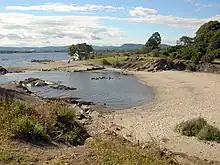59°53′46″N 10°40′30″E / 59.896°N 10.675°E

Huk is a parkland and a sandy beach (Hukodden) at the furthest south of the Bygdøy peninsula west of the city center of Oslo, Norway.
The area was acquired by Aker municipality in 1921.[1] The bathing beach is divided into a regular public beach and a naturist beach area. The naturist beach is on a shank[2][3] northwest of Hukodden, formerly the garden of the brush manufacturer Jordan.[4][5]
Jens Stoltenberg's second government bought in 2005 a villa with shoreline bordering the public beach at Huk, and in 2006 opened a new public beach there.[6] The villa was later resold but the shoreline is still open for all.[7]
Just off the beach area are sculptures, Large Arch (1963–1969) by Henry Moore[8] and Icarus (1965) and Døhlen by Anne Sofie Døhlen (1967).[1]
The area is accessible by bus number 30 from central Oslo.[9]

References
- 1 2 Knut Are Tvedt, ed. (2000). Oslo byleksikon (4th ed.). Oslo: Kunnskapsforlaget. p. 209. (in Norwegian) ISBN 82-573-0815-3
- ↑ Huk naturiststrand på Bygdøy www,nudist.no (in Norwegian)
- ↑ Huk Naturiststrand www.oslofjorden.com (in Norwegian)
- ↑ NRK – Første gang på naturiststrand» NRK (in Norwegian)
- ↑ Huk & Paradisbukta www.visitnorway.com (in English)
- ↑ Huk-eiendommen på Bygdøy sikres som friluftsområde Government of Norway Oct 21, 2005 (in Norwegian)
- ↑ Huk badeplass, Bygdø (in Norwegian)
- ↑ Henry Moore Store norske leksikon (in Norwegian)
- ↑ Bus line 30 Archived 2015-12-08 at the Wayback Machine www.ruter.no 30 Nydalen-Bygdøy](in Norwegian)